Organisational Structure, Culture, Management in Public Sector Report
VerifiedAdded on 2023/01/04
|14
|4481
|72
Report
AI Summary
This report delves into the organisational structure of public companies, focusing on the National Health Service (NHS) in the UK. It examines different organisational structures like legislation and council, statutory and holding companies, and government companies, highlighting how they operate and are funded. The report explores the concept of organisational culture, including Handy's culture and Hofstede’s dimensions, and their influence on employee behavior. It also analyzes the impact of central and local government on public sector operations, covering financial contributions, legal regulations, and the development of healthcare workforces. Furthermore, the report discusses various management styles, such as authoritarian and visionary approaches, and their application within public companies. Finally, it investigates the relationship between motivation and organisational behavior, and their impact on performance.
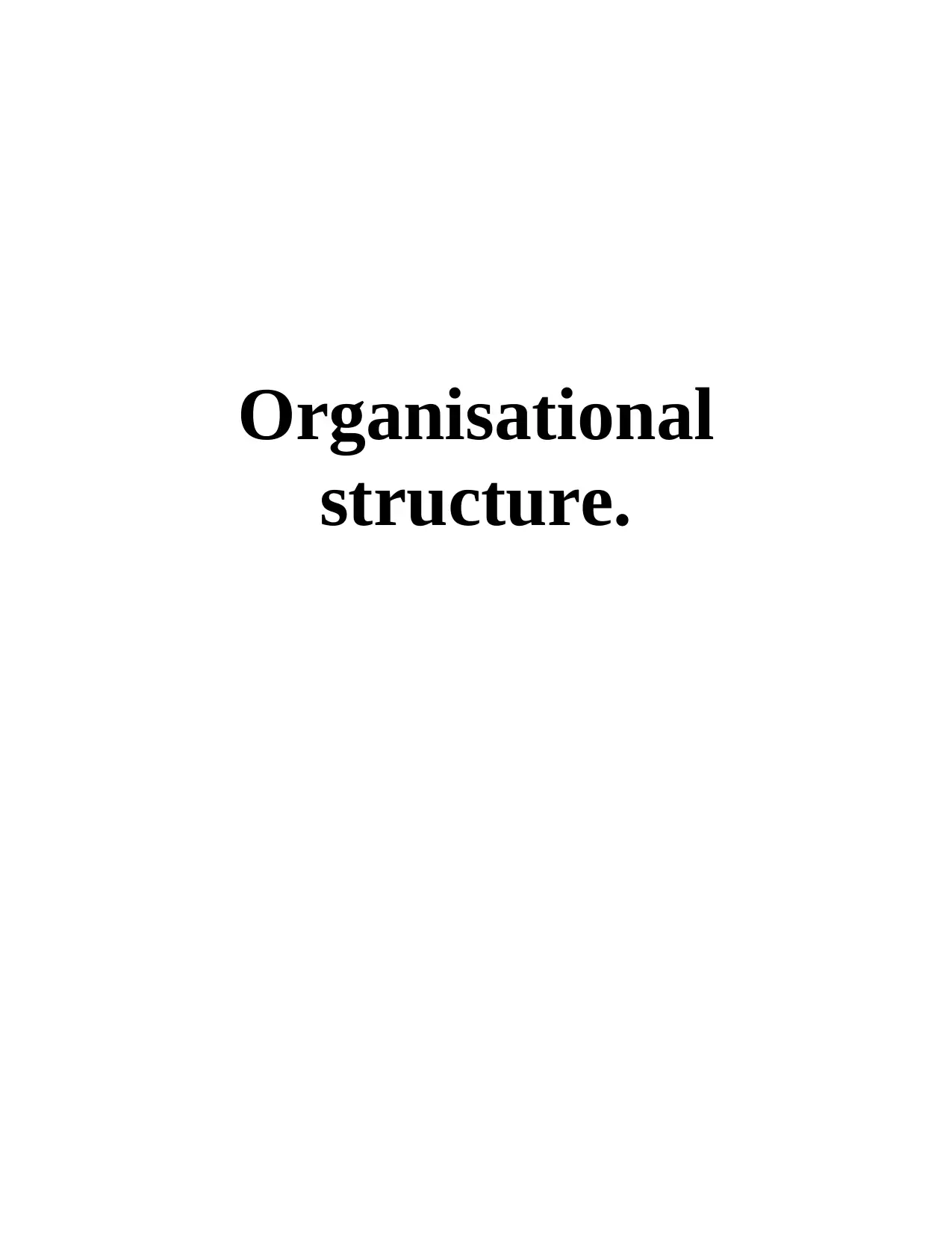
Organisational
structure.
structure.
Paraphrase This Document
Need a fresh take? Get an instant paraphrase of this document with our AI Paraphraser
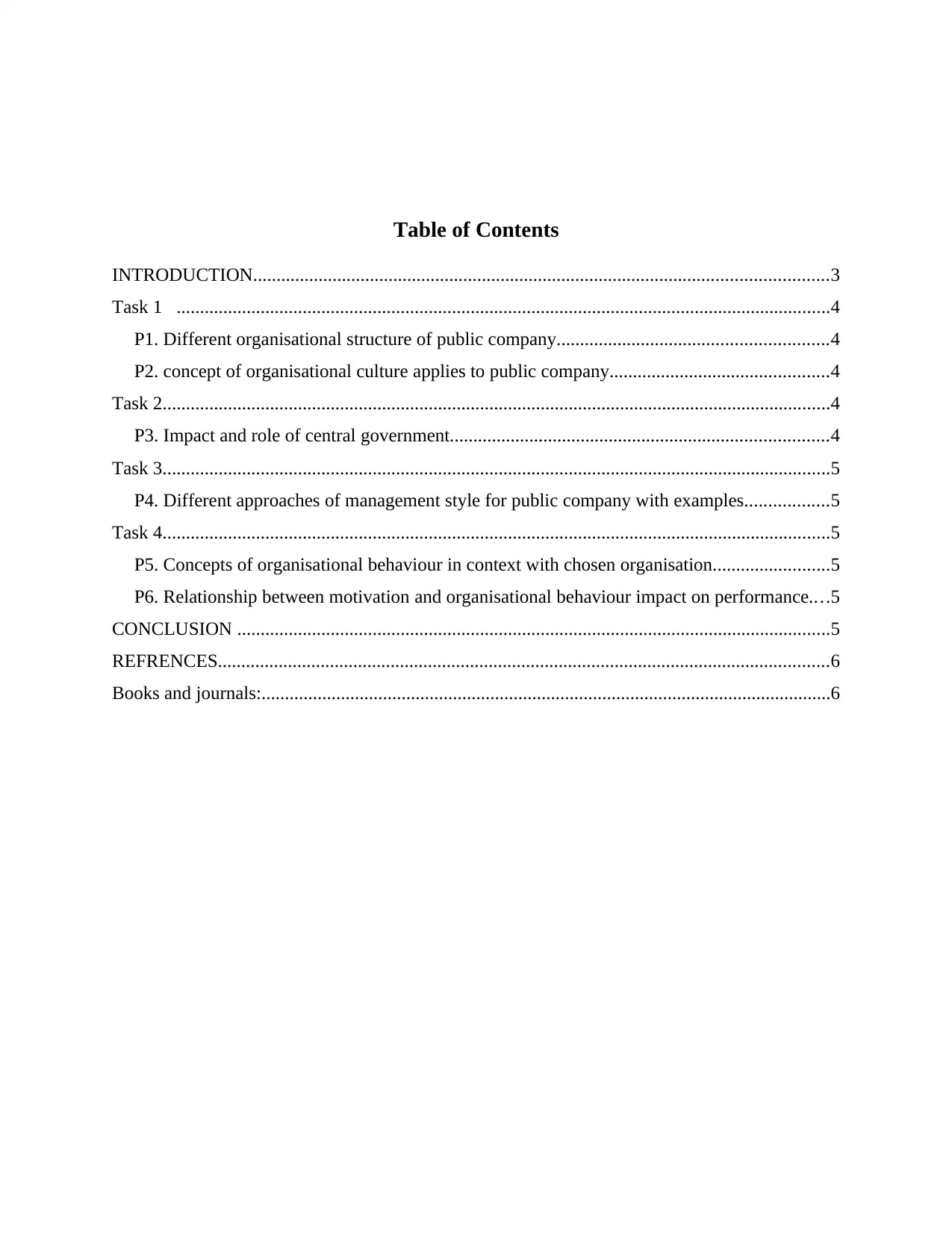
Table of Contents
INTRODUCTION...........................................................................................................................3
Task 1 ............................................................................................................................................4
P1. Different organisational structure of public company..........................................................4
P2. concept of organisational culture applies to public company...............................................4
Task 2...............................................................................................................................................4
P3. Impact and role of central government.................................................................................4
Task 3...............................................................................................................................................5
P4. Different approaches of management style for public company with examples..................5
Task 4...............................................................................................................................................5
P5. Concepts of organisational behaviour in context with chosen organisation.........................5
P6. Relationship between motivation and organisational behaviour impact on performance....5
CONCLUSION ...............................................................................................................................5
REFRENCES...................................................................................................................................6
Books and journals:..........................................................................................................................6
INTRODUCTION...........................................................................................................................3
Task 1 ............................................................................................................................................4
P1. Different organisational structure of public company..........................................................4
P2. concept of organisational culture applies to public company...............................................4
Task 2...............................................................................................................................................4
P3. Impact and role of central government.................................................................................4
Task 3...............................................................................................................................................5
P4. Different approaches of management style for public company with examples..................5
Task 4...............................................................................................................................................5
P5. Concepts of organisational behaviour in context with chosen organisation.........................5
P6. Relationship between motivation and organisational behaviour impact on performance....5
CONCLUSION ...............................................................................................................................5
REFRENCES...................................................................................................................................6
Books and journals:..........................................................................................................................6
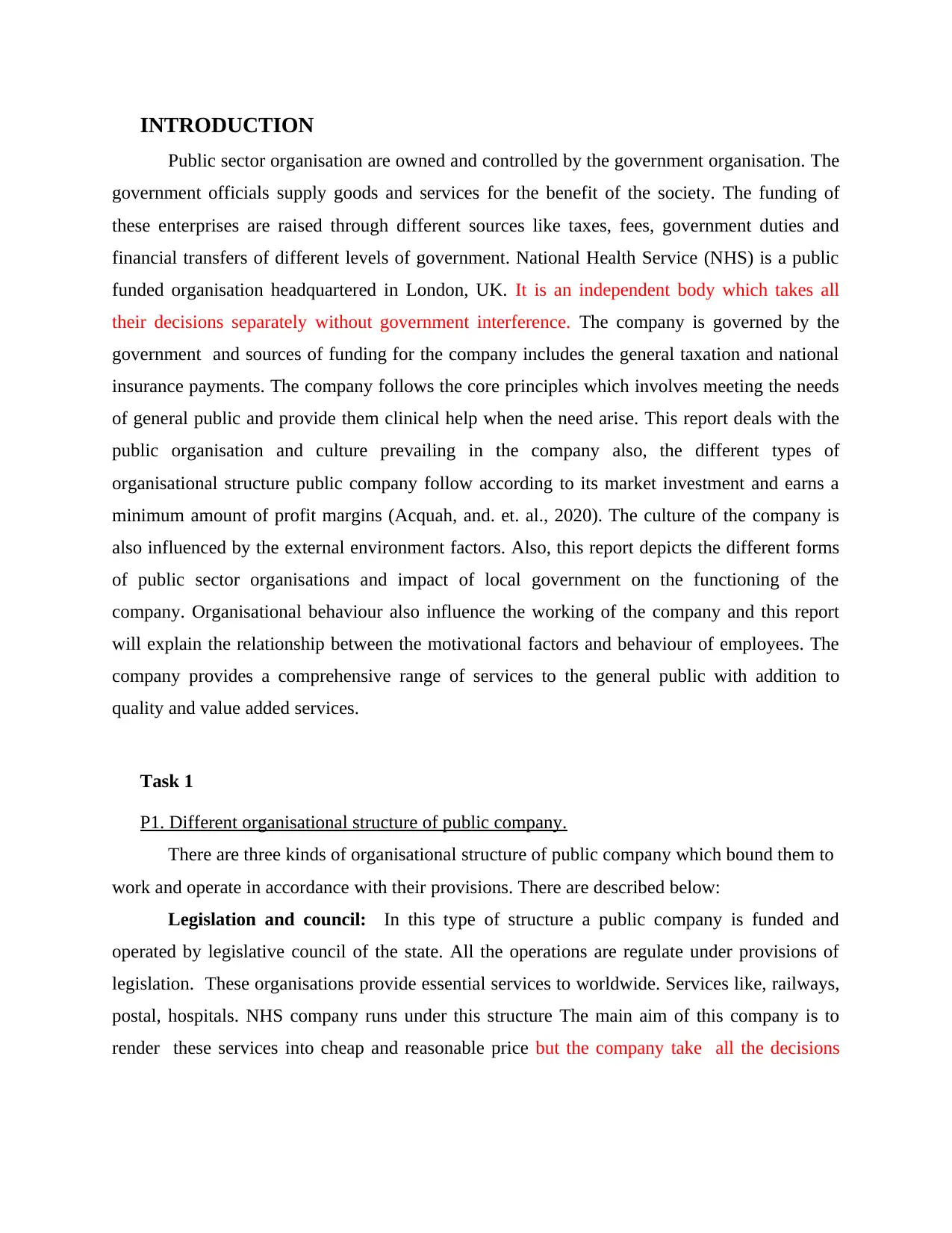
INTRODUCTION
Public sector organisation are owned and controlled by the government organisation. The
government officials supply goods and services for the benefit of the society. The funding of
these enterprises are raised through different sources like taxes, fees, government duties and
financial transfers of different levels of government. National Health Service (NHS) is a public
funded organisation headquartered in London, UK. It is an independent body which takes all
their decisions separately without government interference. The company is governed by the
government and sources of funding for the company includes the general taxation and national
insurance payments. The company follows the core principles which involves meeting the needs
of general public and provide them clinical help when the need arise. This report deals with the
public organisation and culture prevailing in the company also, the different types of
organisational structure public company follow according to its market investment and earns a
minimum amount of profit margins (Acquah, and. et. al., 2020). The culture of the company is
also influenced by the external environment factors. Also, this report depicts the different forms
of public sector organisations and impact of local government on the functioning of the
company. Organisational behaviour also influence the working of the company and this report
will explain the relationship between the motivational factors and behaviour of employees. The
company provides a comprehensive range of services to the general public with addition to
quality and value added services.
Task 1
P1. Different organisational structure of public company.
There are three kinds of organisational structure of public company which bound them to
work and operate in accordance with their provisions. There are described below:
Legislation and council: In this type of structure a public company is funded and
operated by legislative council of the state. All the operations are regulate under provisions of
legislation. These organisations provide essential services to worldwide. Services like, railways,
postal, hospitals. NHS company runs under this structure The main aim of this company is to
render these services into cheap and reasonable price but the company take all the decisions
Public sector organisation are owned and controlled by the government organisation. The
government officials supply goods and services for the benefit of the society. The funding of
these enterprises are raised through different sources like taxes, fees, government duties and
financial transfers of different levels of government. National Health Service (NHS) is a public
funded organisation headquartered in London, UK. It is an independent body which takes all
their decisions separately without government interference. The company is governed by the
government and sources of funding for the company includes the general taxation and national
insurance payments. The company follows the core principles which involves meeting the needs
of general public and provide them clinical help when the need arise. This report deals with the
public organisation and culture prevailing in the company also, the different types of
organisational structure public company follow according to its market investment and earns a
minimum amount of profit margins (Acquah, and. et. al., 2020). The culture of the company is
also influenced by the external environment factors. Also, this report depicts the different forms
of public sector organisations and impact of local government on the functioning of the
company. Organisational behaviour also influence the working of the company and this report
will explain the relationship between the motivational factors and behaviour of employees. The
company provides a comprehensive range of services to the general public with addition to
quality and value added services.
Task 1
P1. Different organisational structure of public company.
There are three kinds of organisational structure of public company which bound them to
work and operate in accordance with their provisions. There are described below:
Legislation and council: In this type of structure a public company is funded and
operated by legislative council of the state. All the operations are regulate under provisions of
legislation. These organisations provide essential services to worldwide. Services like, railways,
postal, hospitals. NHS company runs under this structure The main aim of this company is to
render these services into cheap and reasonable price but the company take all the decisions
⊘ This is a preview!⊘
Do you want full access?
Subscribe today to unlock all pages.

Trusted by 1+ million students worldwide
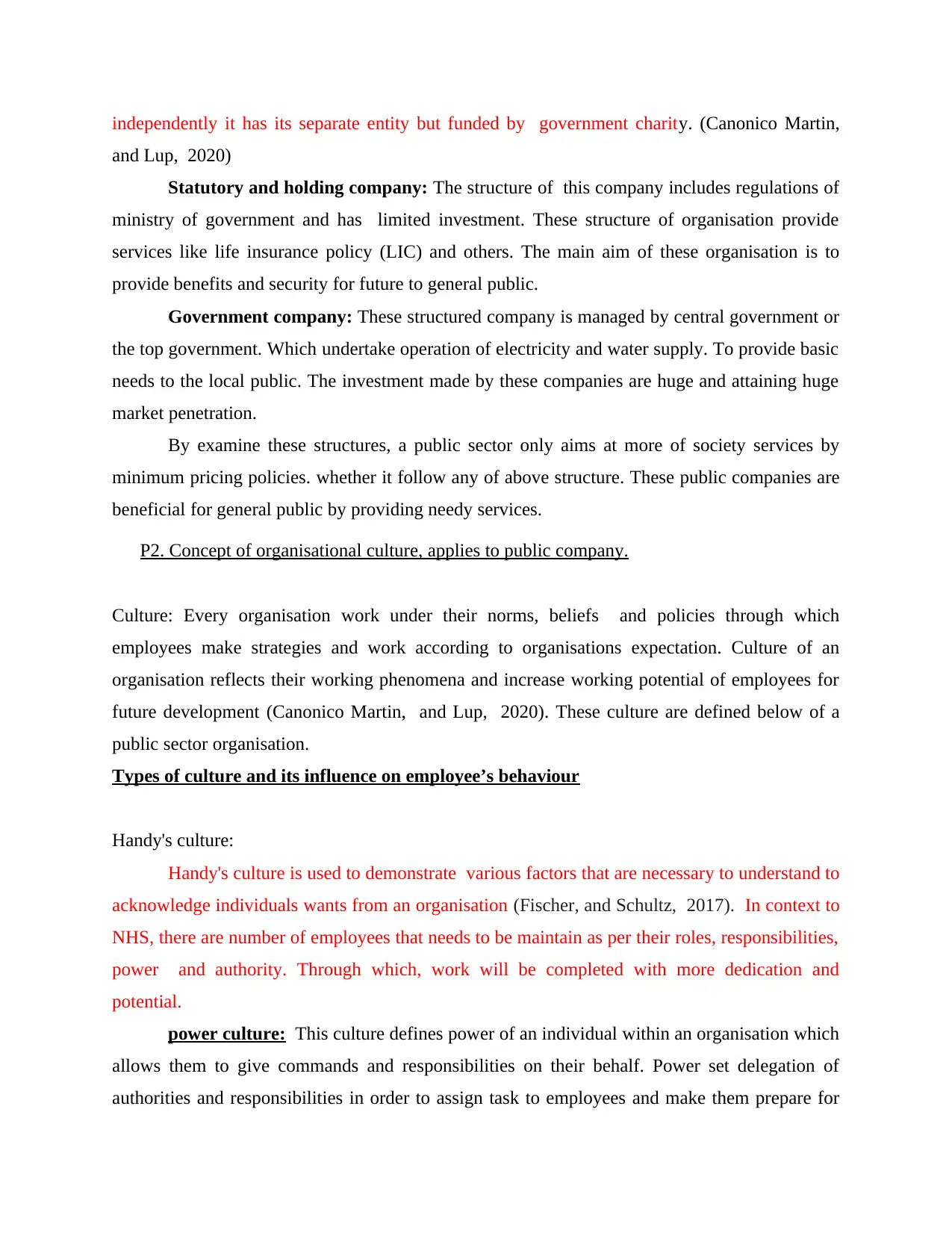
independently it has its separate entity but funded by government charity. (Canonico Martin,
and Lup, 2020)
Statutory and holding company: The structure of this company includes regulations of
ministry of government and has limited investment. These structure of organisation provide
services like life insurance policy (LIC) and others. The main aim of these organisation is to
provide benefits and security for future to general public.
Government company: These structured company is managed by central government or
the top government. Which undertake operation of electricity and water supply. To provide basic
needs to the local public. The investment made by these companies are huge and attaining huge
market penetration.
By examine these structures, a public sector only aims at more of society services by
minimum pricing policies. whether it follow any of above structure. These public companies are
beneficial for general public by providing needy services.
P2. Concept of organisational culture, applies to public company.
Culture: Every organisation work under their norms, beliefs and policies through which
employees make strategies and work according to organisations expectation. Culture of an
organisation reflects their working phenomena and increase working potential of employees for
future development (Canonico Martin, and Lup, 2020). These culture are defined below of a
public sector organisation.
Types of culture and its influence on employee’s behaviour
Handy's culture:
Handy's culture is used to demonstrate various factors that are necessary to understand to
acknowledge individuals wants from an organisation (Fischer, and Schultz, 2017). In context to
NHS, there are number of employees that needs to be maintain as per their roles, responsibilities,
power and authority. Through which, work will be completed with more dedication and
potential.
power culture: This culture defines power of an individual within an organisation which
allows them to give commands and responsibilities on their behalf. Power set delegation of
authorities and responsibilities in order to assign task to employees and make them prepare for
and Lup, 2020)
Statutory and holding company: The structure of this company includes regulations of
ministry of government and has limited investment. These structure of organisation provide
services like life insurance policy (LIC) and others. The main aim of these organisation is to
provide benefits and security for future to general public.
Government company: These structured company is managed by central government or
the top government. Which undertake operation of electricity and water supply. To provide basic
needs to the local public. The investment made by these companies are huge and attaining huge
market penetration.
By examine these structures, a public sector only aims at more of society services by
minimum pricing policies. whether it follow any of above structure. These public companies are
beneficial for general public by providing needy services.
P2. Concept of organisational culture, applies to public company.
Culture: Every organisation work under their norms, beliefs and policies through which
employees make strategies and work according to organisations expectation. Culture of an
organisation reflects their working phenomena and increase working potential of employees for
future development (Canonico Martin, and Lup, 2020). These culture are defined below of a
public sector organisation.
Types of culture and its influence on employee’s behaviour
Handy's culture:
Handy's culture is used to demonstrate various factors that are necessary to understand to
acknowledge individuals wants from an organisation (Fischer, and Schultz, 2017). In context to
NHS, there are number of employees that needs to be maintain as per their roles, responsibilities,
power and authority. Through which, work will be completed with more dedication and
potential.
power culture: This culture defines power of an individual within an organisation which
allows them to give commands and responsibilities on their behalf. Power set delegation of
authorities and responsibilities in order to assign task to employees and make them prepare for
Paraphrase This Document
Need a fresh take? Get an instant paraphrase of this document with our AI Paraphraser
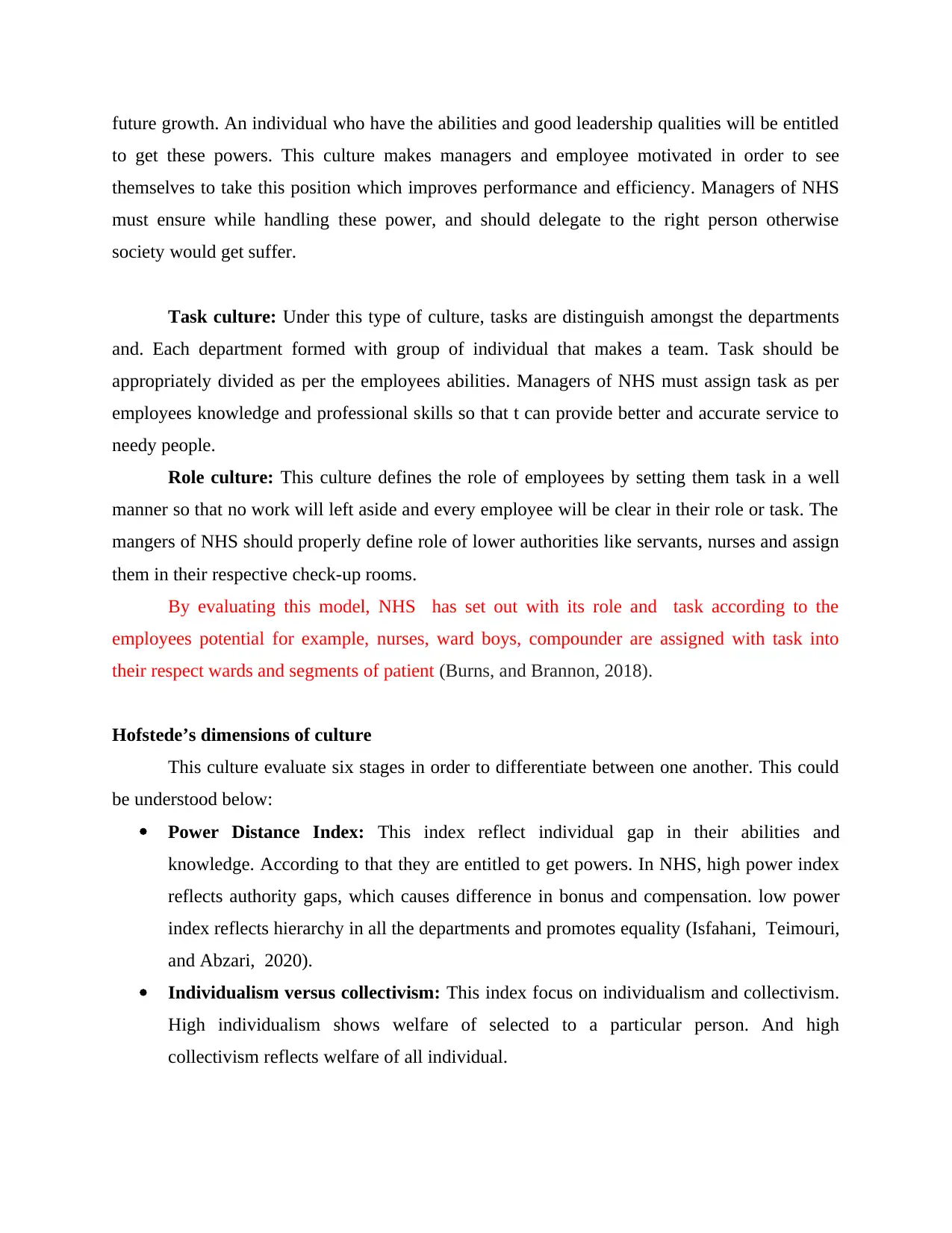
future growth. An individual who have the abilities and good leadership qualities will be entitled
to get these powers. This culture makes managers and employee motivated in order to see
themselves to take this position which improves performance and efficiency. Managers of NHS
must ensure while handling these power, and should delegate to the right person otherwise
society would get suffer.
Task culture: Under this type of culture, tasks are distinguish amongst the departments
and. Each department formed with group of individual that makes a team. Task should be
appropriately divided as per the employees abilities. Managers of NHS must assign task as per
employees knowledge and professional skills so that t can provide better and accurate service to
needy people.
Role culture: This culture defines the role of employees by setting them task in a well
manner so that no work will left aside and every employee will be clear in their role or task. The
mangers of NHS should properly define role of lower authorities like servants, nurses and assign
them in their respective check-up rooms.
By evaluating this model, NHS has set out with its role and task according to the
employees potential for example, nurses, ward boys, compounder are assigned with task into
their respect wards and segments of patient (Burns, and Brannon, 2018).
Hofstede’s dimensions of culture
This culture evaluate six stages in order to differentiate between one another. This could
be understood below:
Power Distance Index: This index reflect individual gap in their abilities and
knowledge. According to that they are entitled to get powers. In NHS, high power index
reflects authority gaps, which causes difference in bonus and compensation. low power
index reflects hierarchy in all the departments and promotes equality (Isfahani, Teimouri,
and Abzari, 2020).
Individualism versus collectivism: This index focus on individualism and collectivism.
High individualism shows welfare of selected to a particular person. And high
collectivism reflects welfare of all individual.
to get these powers. This culture makes managers and employee motivated in order to see
themselves to take this position which improves performance and efficiency. Managers of NHS
must ensure while handling these power, and should delegate to the right person otherwise
society would get suffer.
Task culture: Under this type of culture, tasks are distinguish amongst the departments
and. Each department formed with group of individual that makes a team. Task should be
appropriately divided as per the employees abilities. Managers of NHS must assign task as per
employees knowledge and professional skills so that t can provide better and accurate service to
needy people.
Role culture: This culture defines the role of employees by setting them task in a well
manner so that no work will left aside and every employee will be clear in their role or task. The
mangers of NHS should properly define role of lower authorities like servants, nurses and assign
them in their respective check-up rooms.
By evaluating this model, NHS has set out with its role and task according to the
employees potential for example, nurses, ward boys, compounder are assigned with task into
their respect wards and segments of patient (Burns, and Brannon, 2018).
Hofstede’s dimensions of culture
This culture evaluate six stages in order to differentiate between one another. This could
be understood below:
Power Distance Index: This index reflect individual gap in their abilities and
knowledge. According to that they are entitled to get powers. In NHS, high power index
reflects authority gaps, which causes difference in bonus and compensation. low power
index reflects hierarchy in all the departments and promotes equality (Isfahani, Teimouri,
and Abzari, 2020).
Individualism versus collectivism: This index focus on individualism and collectivism.
High individualism shows welfare of selected to a particular person. And high
collectivism reflects welfare of all individual.
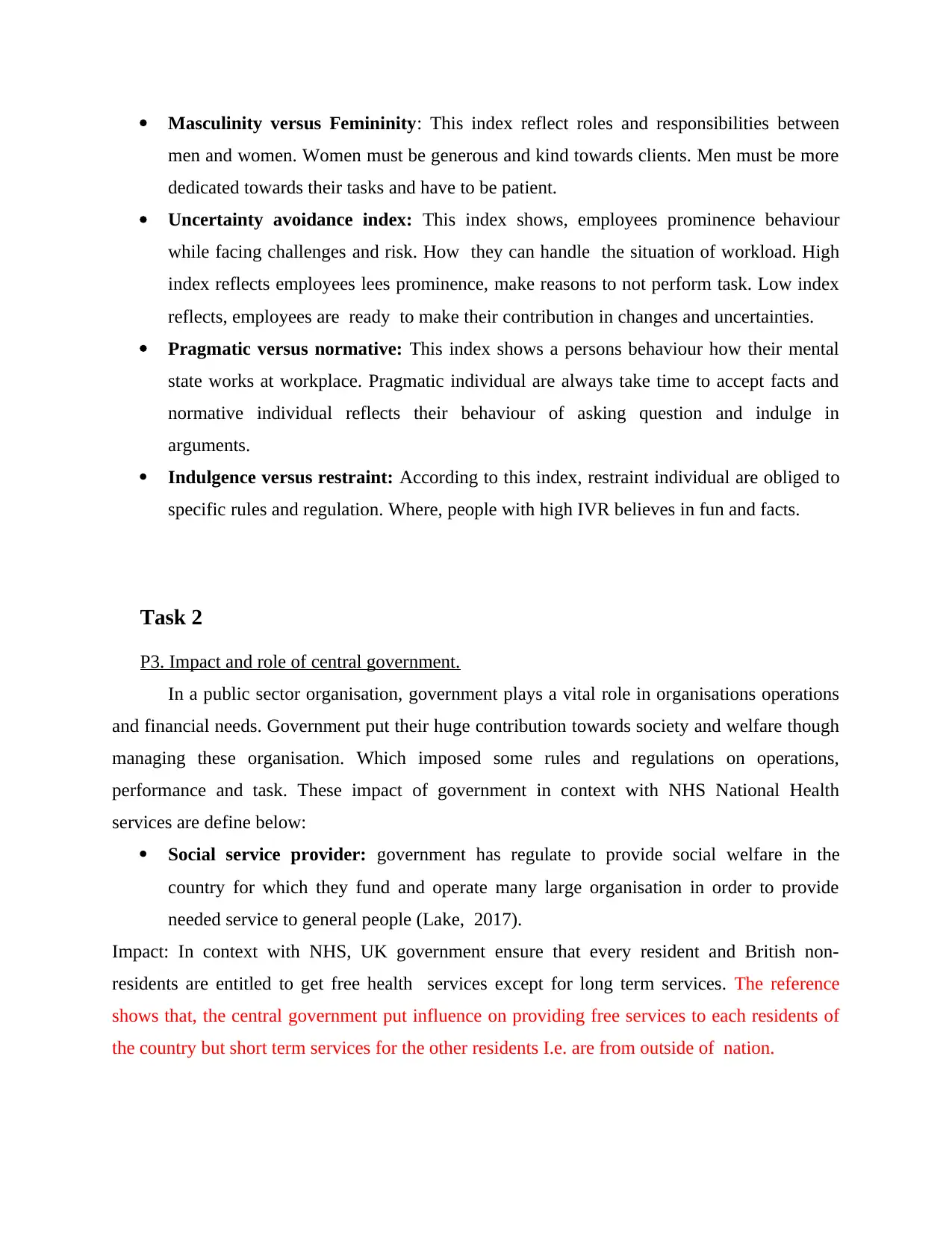
Masculinity versus Femininity: This index reflect roles and responsibilities between
men and women. Women must be generous and kind towards clients. Men must be more
dedicated towards their tasks and have to be patient.
Uncertainty avoidance index: This index shows, employees prominence behaviour
while facing challenges and risk. How they can handle the situation of workload. High
index reflects employees lees prominence, make reasons to not perform task. Low index
reflects, employees are ready to make their contribution in changes and uncertainties.
Pragmatic versus normative: This index shows a persons behaviour how their mental
state works at workplace. Pragmatic individual are always take time to accept facts and
normative individual reflects their behaviour of asking question and indulge in
arguments.
Indulgence versus restraint: According to this index, restraint individual are obliged to
specific rules and regulation. Where, people with high IVR believes in fun and facts.
Task 2
P3. Impact and role of central government.
In a public sector organisation, government plays a vital role in organisations operations
and financial needs. Government put their huge contribution towards society and welfare though
managing these organisation. Which imposed some rules and regulations on operations,
performance and task. These impact of government in context with NHS National Health
services are define below:
Social service provider: government has regulate to provide social welfare in the
country for which they fund and operate many large organisation in order to provide
needed service to general people (Lake, 2017).
Impact: In context with NHS, UK government ensure that every resident and British non-
residents are entitled to get free health services except for long term services. The reference
shows that, the central government put influence on providing free services to each residents of
the country but short term services for the other residents I.e. are from outside of nation.
men and women. Women must be generous and kind towards clients. Men must be more
dedicated towards their tasks and have to be patient.
Uncertainty avoidance index: This index shows, employees prominence behaviour
while facing challenges and risk. How they can handle the situation of workload. High
index reflects employees lees prominence, make reasons to not perform task. Low index
reflects, employees are ready to make their contribution in changes and uncertainties.
Pragmatic versus normative: This index shows a persons behaviour how their mental
state works at workplace. Pragmatic individual are always take time to accept facts and
normative individual reflects their behaviour of asking question and indulge in
arguments.
Indulgence versus restraint: According to this index, restraint individual are obliged to
specific rules and regulation. Where, people with high IVR believes in fun and facts.
Task 2
P3. Impact and role of central government.
In a public sector organisation, government plays a vital role in organisations operations
and financial needs. Government put their huge contribution towards society and welfare though
managing these organisation. Which imposed some rules and regulations on operations,
performance and task. These impact of government in context with NHS National Health
services are define below:
Social service provider: government has regulate to provide social welfare in the
country for which they fund and operate many large organisation in order to provide
needed service to general people (Lake, 2017).
Impact: In context with NHS, UK government ensure that every resident and British non-
residents are entitled to get free health services except for long term services. The reference
shows that, the central government put influence on providing free services to each residents of
the country but short term services for the other residents I.e. are from outside of nation.
⊘ This is a preview!⊘
Do you want full access?
Subscribe today to unlock all pages.

Trusted by 1+ million students worldwide
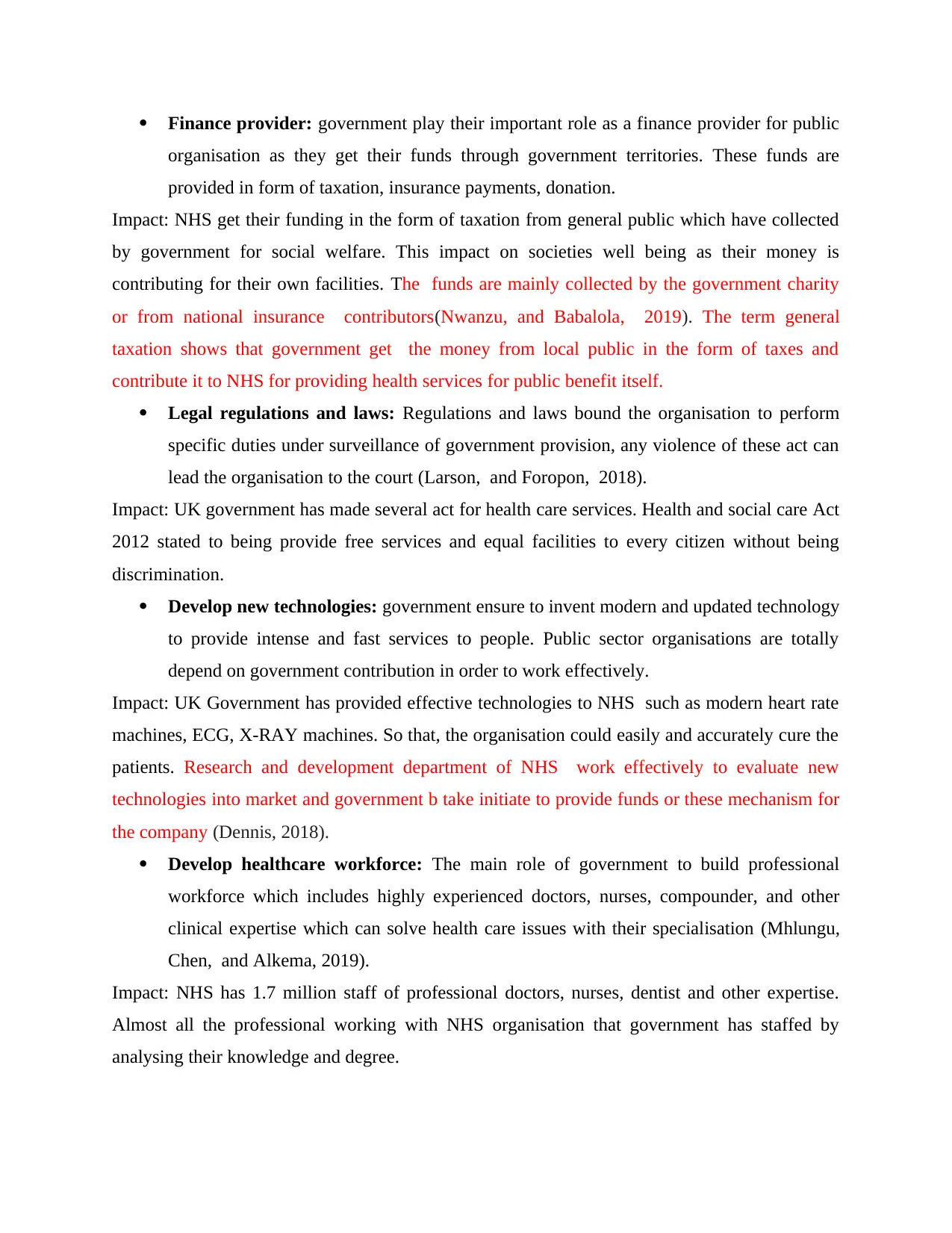
Finance provider: government play their important role as a finance provider for public
organisation as they get their funds through government territories. These funds are
provided in form of taxation, insurance payments, donation.
Impact: NHS get their funding in the form of taxation from general public which have collected
by government for social welfare. This impact on societies well being as their money is
contributing for their own facilities. The funds are mainly collected by the government charity
or from national insurance contributors(Nwanzu, and Babalola, 2019). The term general
taxation shows that government get the money from local public in the form of taxes and
contribute it to NHS for providing health services for public benefit itself.
Legal regulations and laws: Regulations and laws bound the organisation to perform
specific duties under surveillance of government provision, any violence of these act can
lead the organisation to the court (Larson, and Foropon, 2018).
Impact: UK government has made several act for health care services. Health and social care Act
2012 stated to being provide free services and equal facilities to every citizen without being
discrimination.
Develop new technologies: government ensure to invent modern and updated technology
to provide intense and fast services to people. Public sector organisations are totally
depend on government contribution in order to work effectively.
Impact: UK Government has provided effective technologies to NHS such as modern heart rate
machines, ECG, X-RAY machines. So that, the organisation could easily and accurately cure the
patients. Research and development department of NHS work effectively to evaluate new
technologies into market and government b take initiate to provide funds or these mechanism for
the company (Dennis, 2018).
Develop healthcare workforce: The main role of government to build professional
workforce which includes highly experienced doctors, nurses, compounder, and other
clinical expertise which can solve health care issues with their specialisation (Mhlungu,
Chen, and Alkema, 2019).
Impact: NHS has 1.7 million staff of professional doctors, nurses, dentist and other expertise.
Almost all the professional working with NHS organisation that government has staffed by
analysing their knowledge and degree.
organisation as they get their funds through government territories. These funds are
provided in form of taxation, insurance payments, donation.
Impact: NHS get their funding in the form of taxation from general public which have collected
by government for social welfare. This impact on societies well being as their money is
contributing for their own facilities. The funds are mainly collected by the government charity
or from national insurance contributors(Nwanzu, and Babalola, 2019). The term general
taxation shows that government get the money from local public in the form of taxes and
contribute it to NHS for providing health services for public benefit itself.
Legal regulations and laws: Regulations and laws bound the organisation to perform
specific duties under surveillance of government provision, any violence of these act can
lead the organisation to the court (Larson, and Foropon, 2018).
Impact: UK government has made several act for health care services. Health and social care Act
2012 stated to being provide free services and equal facilities to every citizen without being
discrimination.
Develop new technologies: government ensure to invent modern and updated technology
to provide intense and fast services to people. Public sector organisations are totally
depend on government contribution in order to work effectively.
Impact: UK Government has provided effective technologies to NHS such as modern heart rate
machines, ECG, X-RAY machines. So that, the organisation could easily and accurately cure the
patients. Research and development department of NHS work effectively to evaluate new
technologies into market and government b take initiate to provide funds or these mechanism for
the company (Dennis, 2018).
Develop healthcare workforce: The main role of government to build professional
workforce which includes highly experienced doctors, nurses, compounder, and other
clinical expertise which can solve health care issues with their specialisation (Mhlungu,
Chen, and Alkema, 2019).
Impact: NHS has 1.7 million staff of professional doctors, nurses, dentist and other expertise.
Almost all the professional working with NHS organisation that government has staffed by
analysing their knowledge and degree.
Paraphrase This Document
Need a fresh take? Get an instant paraphrase of this document with our AI Paraphraser
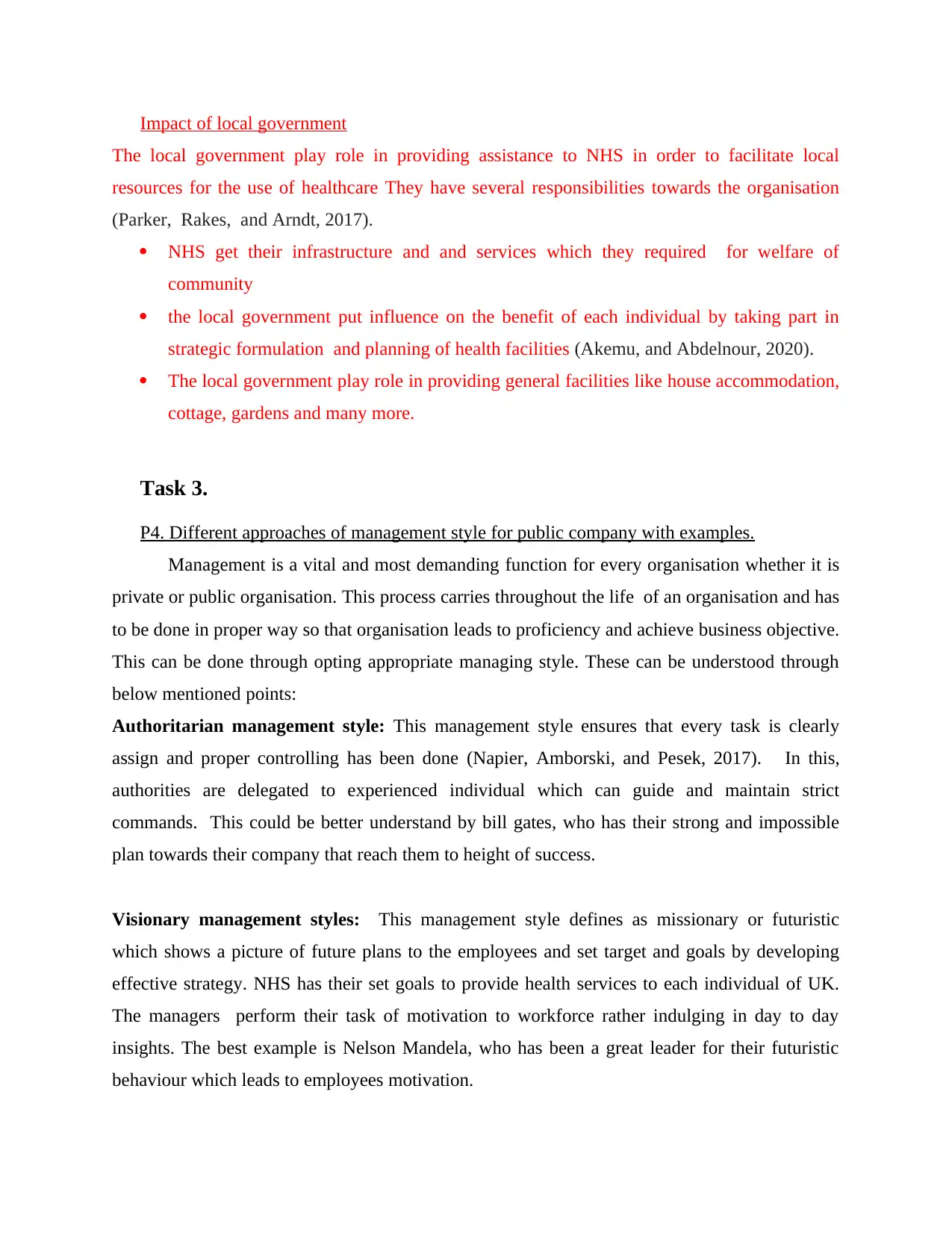
Impact of local government
The local government play role in providing assistance to NHS in order to facilitate local
resources for the use of healthcare They have several responsibilities towards the organisation
(Parker, Rakes, and Arndt, 2017).
NHS get their infrastructure and and services which they required for welfare of
community
the local government put influence on the benefit of each individual by taking part in
strategic formulation and planning of health facilities (Akemu, and Abdelnour, 2020).
The local government play role in providing general facilities like house accommodation,
cottage, gardens and many more.
Task 3.
P4. Different approaches of management style for public company with examples.
Management is a vital and most demanding function for every organisation whether it is
private or public organisation. This process carries throughout the life of an organisation and has
to be done in proper way so that organisation leads to proficiency and achieve business objective.
This can be done through opting appropriate managing style. These can be understood through
below mentioned points:
Authoritarian management style: This management style ensures that every task is clearly
assign and proper controlling has been done (Napier, Amborski, and Pesek, 2017). In this,
authorities are delegated to experienced individual which can guide and maintain strict
commands. This could be better understand by bill gates, who has their strong and impossible
plan towards their company that reach them to height of success.
Visionary management styles: This management style defines as missionary or futuristic
which shows a picture of future plans to the employees and set target and goals by developing
effective strategy. NHS has their set goals to provide health services to each individual of UK.
The managers perform their task of motivation to workforce rather indulging in day to day
insights. The best example is Nelson Mandela, who has been a great leader for their futuristic
behaviour which leads to employees motivation.
The local government play role in providing assistance to NHS in order to facilitate local
resources for the use of healthcare They have several responsibilities towards the organisation
(Parker, Rakes, and Arndt, 2017).
NHS get their infrastructure and and services which they required for welfare of
community
the local government put influence on the benefit of each individual by taking part in
strategic formulation and planning of health facilities (Akemu, and Abdelnour, 2020).
The local government play role in providing general facilities like house accommodation,
cottage, gardens and many more.
Task 3.
P4. Different approaches of management style for public company with examples.
Management is a vital and most demanding function for every organisation whether it is
private or public organisation. This process carries throughout the life of an organisation and has
to be done in proper way so that organisation leads to proficiency and achieve business objective.
This can be done through opting appropriate managing style. These can be understood through
below mentioned points:
Authoritarian management style: This management style ensures that every task is clearly
assign and proper controlling has been done (Napier, Amborski, and Pesek, 2017). In this,
authorities are delegated to experienced individual which can guide and maintain strict
commands. This could be better understand by bill gates, who has their strong and impossible
plan towards their company that reach them to height of success.
Visionary management styles: This management style defines as missionary or futuristic
which shows a picture of future plans to the employees and set target and goals by developing
effective strategy. NHS has their set goals to provide health services to each individual of UK.
The managers perform their task of motivation to workforce rather indulging in day to day
insights. The best example is Nelson Mandela, who has been a great leader for their futuristic
behaviour which leads to employees motivation.
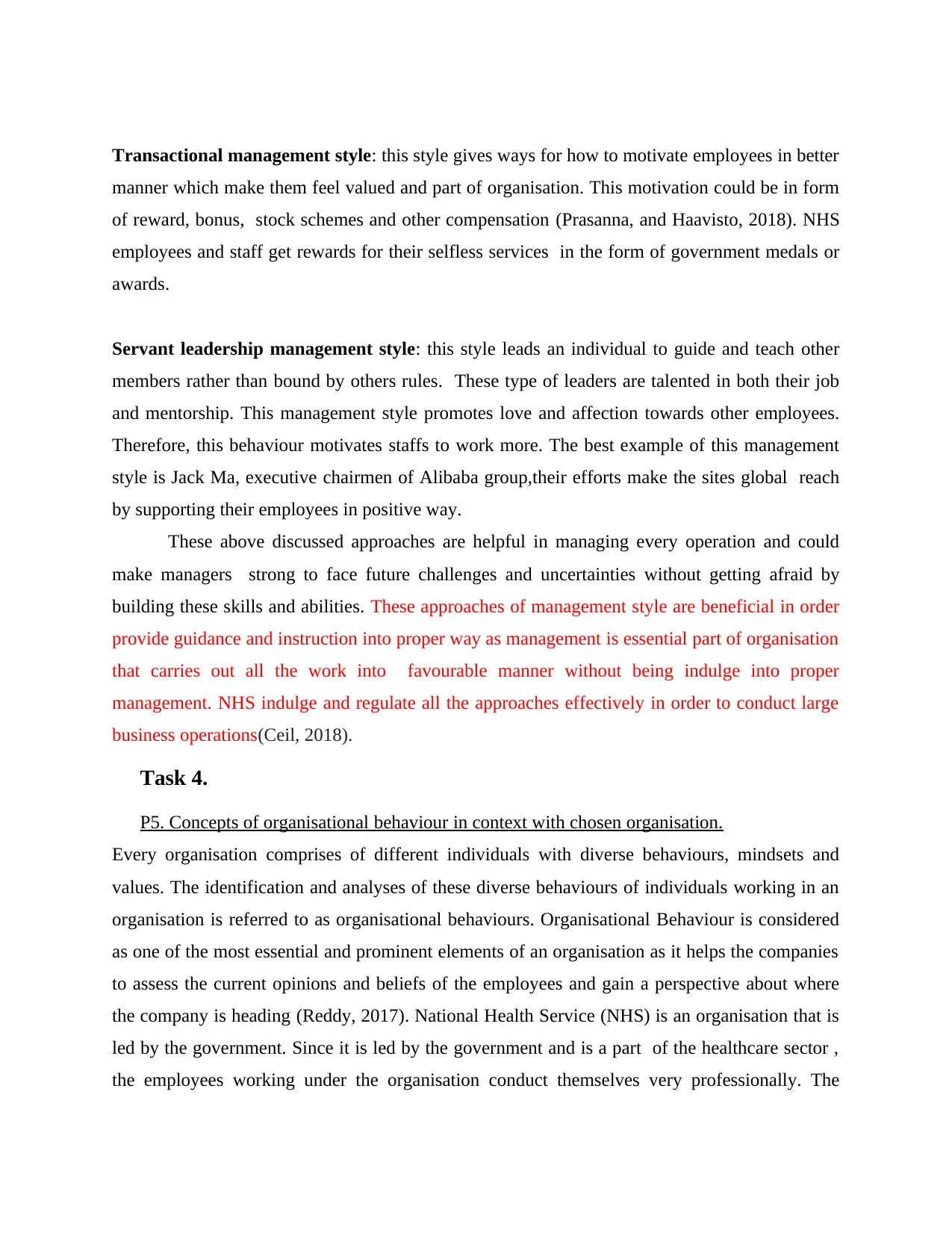
Transactional management style: this style gives ways for how to motivate employees in better
manner which make them feel valued and part of organisation. This motivation could be in form
of reward, bonus, stock schemes and other compensation (Prasanna, and Haavisto, 2018). NHS
employees and staff get rewards for their selfless services in the form of government medals or
awards.
Servant leadership management style: this style leads an individual to guide and teach other
members rather than bound by others rules. These type of leaders are talented in both their job
and mentorship. This management style promotes love and affection towards other employees.
Therefore, this behaviour motivates staffs to work more. The best example of this management
style is Jack Ma, executive chairmen of Alibaba group,their efforts make the sites global reach
by supporting their employees in positive way.
These above discussed approaches are helpful in managing every operation and could
make managers strong to face future challenges and uncertainties without getting afraid by
building these skills and abilities. These approaches of management style are beneficial in order
provide guidance and instruction into proper way as management is essential part of organisation
that carries out all the work into favourable manner without being indulge into proper
management. NHS indulge and regulate all the approaches effectively in order to conduct large
business operations(Ceil, 2018).
Task 4.
P5. Concepts of organisational behaviour in context with chosen organisation.
Every organisation comprises of different individuals with diverse behaviours, mindsets and
values. The identification and analyses of these diverse behaviours of individuals working in an
organisation is referred to as organisational behaviours. Organisational Behaviour is considered
as one of the most essential and prominent elements of an organisation as it helps the companies
to assess the current opinions and beliefs of the employees and gain a perspective about where
the company is heading (Reddy, 2017). National Health Service (NHS) is an organisation that is
led by the government. Since it is led by the government and is a part of the healthcare sector ,
the employees working under the organisation conduct themselves very professionally. The
manner which make them feel valued and part of organisation. This motivation could be in form
of reward, bonus, stock schemes and other compensation (Prasanna, and Haavisto, 2018). NHS
employees and staff get rewards for their selfless services in the form of government medals or
awards.
Servant leadership management style: this style leads an individual to guide and teach other
members rather than bound by others rules. These type of leaders are talented in both their job
and mentorship. This management style promotes love and affection towards other employees.
Therefore, this behaviour motivates staffs to work more. The best example of this management
style is Jack Ma, executive chairmen of Alibaba group,their efforts make the sites global reach
by supporting their employees in positive way.
These above discussed approaches are helpful in managing every operation and could
make managers strong to face future challenges and uncertainties without getting afraid by
building these skills and abilities. These approaches of management style are beneficial in order
provide guidance and instruction into proper way as management is essential part of organisation
that carries out all the work into favourable manner without being indulge into proper
management. NHS indulge and regulate all the approaches effectively in order to conduct large
business operations(Ceil, 2018).
Task 4.
P5. Concepts of organisational behaviour in context with chosen organisation.
Every organisation comprises of different individuals with diverse behaviours, mindsets and
values. The identification and analyses of these diverse behaviours of individuals working in an
organisation is referred to as organisational behaviours. Organisational Behaviour is considered
as one of the most essential and prominent elements of an organisation as it helps the companies
to assess the current opinions and beliefs of the employees and gain a perspective about where
the company is heading (Reddy, 2017). National Health Service (NHS) is an organisation that is
led by the government. Since it is led by the government and is a part of the healthcare sector ,
the employees working under the organisation conduct themselves very professionally. The
⊘ This is a preview!⊘
Do you want full access?
Subscribe today to unlock all pages.

Trusted by 1+ million students worldwide
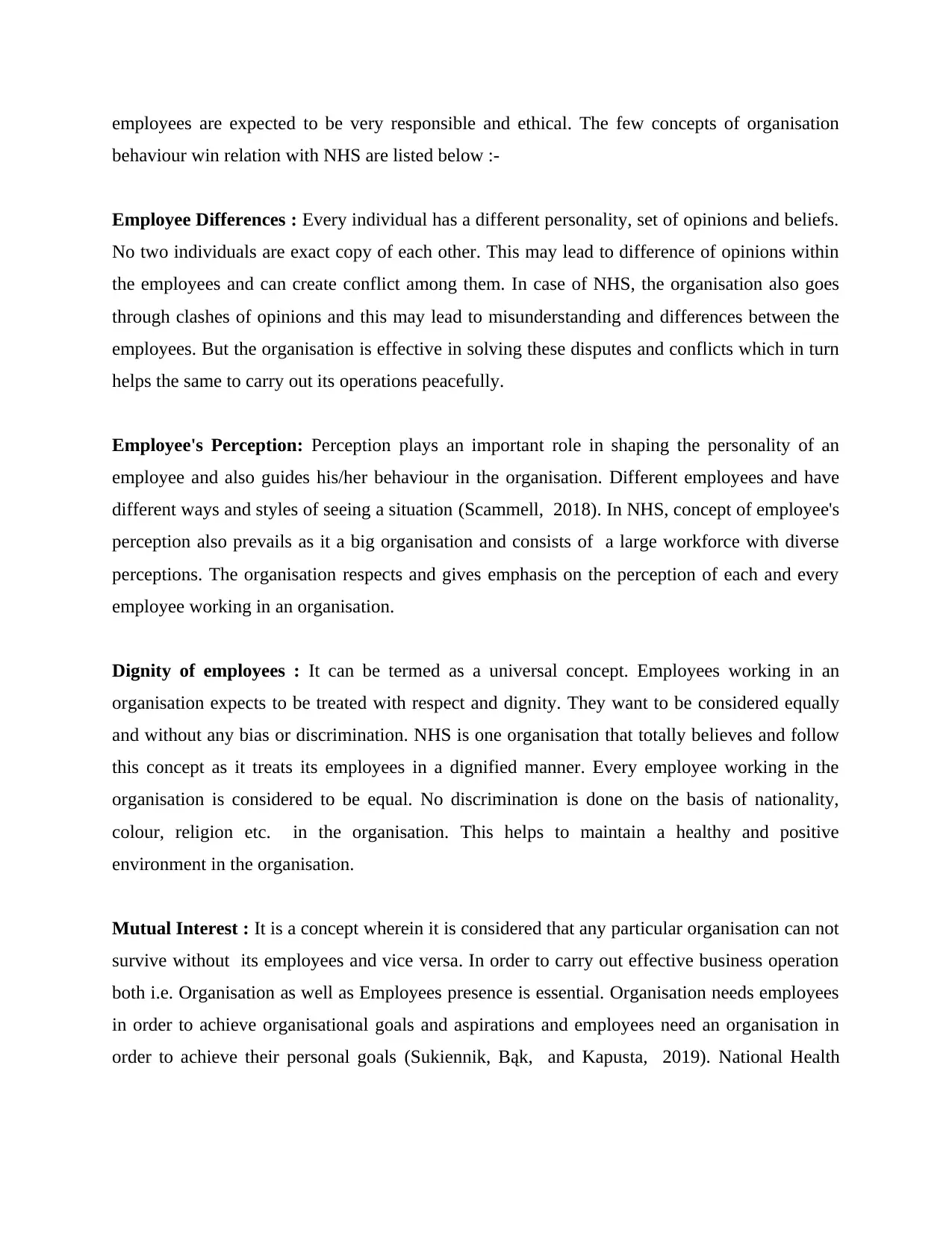
employees are expected to be very responsible and ethical. The few concepts of organisation
behaviour win relation with NHS are listed below :-
Employee Differences : Every individual has a different personality, set of opinions and beliefs.
No two individuals are exact copy of each other. This may lead to difference of opinions within
the employees and can create conflict among them. In case of NHS, the organisation also goes
through clashes of opinions and this may lead to misunderstanding and differences between the
employees. But the organisation is effective in solving these disputes and conflicts which in turn
helps the same to carry out its operations peacefully.
Employee's Perception: Perception plays an important role in shaping the personality of an
employee and also guides his/her behaviour in the organisation. Different employees and have
different ways and styles of seeing a situation (Scammell, 2018). In NHS, concept of employee's
perception also prevails as it a big organisation and consists of a large workforce with diverse
perceptions. The organisation respects and gives emphasis on the perception of each and every
employee working in an organisation.
Dignity of employees : It can be termed as a universal concept. Employees working in an
organisation expects to be treated with respect and dignity. They want to be considered equally
and without any bias or discrimination. NHS is one organisation that totally believes and follow
this concept as it treats its employees in a dignified manner. Every employee working in the
organisation is considered to be equal. No discrimination is done on the basis of nationality,
colour, religion etc. in the organisation. This helps to maintain a healthy and positive
environment in the organisation.
Mutual Interest : It is a concept wherein it is considered that any particular organisation can not
survive without its employees and vice versa. In order to carry out effective business operation
both i.e. Organisation as well as Employees presence is essential. Organisation needs employees
in order to achieve organisational goals and aspirations and employees need an organisation in
order to achieve their personal goals (Sukiennik, Bąk, and Kapusta, 2019). National Health
behaviour win relation with NHS are listed below :-
Employee Differences : Every individual has a different personality, set of opinions and beliefs.
No two individuals are exact copy of each other. This may lead to difference of opinions within
the employees and can create conflict among them. In case of NHS, the organisation also goes
through clashes of opinions and this may lead to misunderstanding and differences between the
employees. But the organisation is effective in solving these disputes and conflicts which in turn
helps the same to carry out its operations peacefully.
Employee's Perception: Perception plays an important role in shaping the personality of an
employee and also guides his/her behaviour in the organisation. Different employees and have
different ways and styles of seeing a situation (Scammell, 2018). In NHS, concept of employee's
perception also prevails as it a big organisation and consists of a large workforce with diverse
perceptions. The organisation respects and gives emphasis on the perception of each and every
employee working in an organisation.
Dignity of employees : It can be termed as a universal concept. Employees working in an
organisation expects to be treated with respect and dignity. They want to be considered equally
and without any bias or discrimination. NHS is one organisation that totally believes and follow
this concept as it treats its employees in a dignified manner. Every employee working in the
organisation is considered to be equal. No discrimination is done on the basis of nationality,
colour, religion etc. in the organisation. This helps to maintain a healthy and positive
environment in the organisation.
Mutual Interest : It is a concept wherein it is considered that any particular organisation can not
survive without its employees and vice versa. In order to carry out effective business operation
both i.e. Organisation as well as Employees presence is essential. Organisation needs employees
in order to achieve organisational goals and aspirations and employees need an organisation in
order to achieve their personal goals (Sukiennik, Bąk, and Kapusta, 2019). National Health
Paraphrase This Document
Need a fresh take? Get an instant paraphrase of this document with our AI Paraphraser
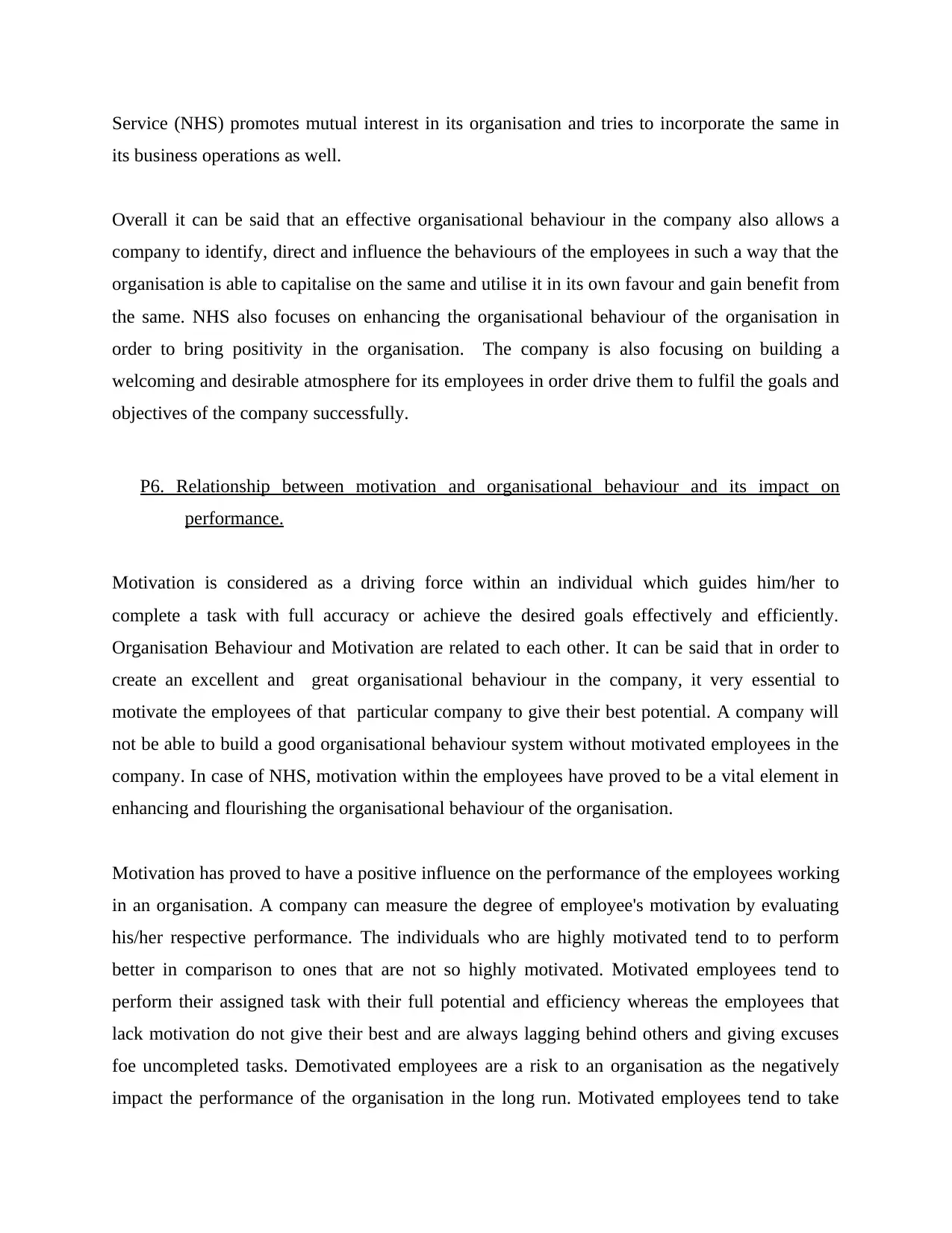
Service (NHS) promotes mutual interest in its organisation and tries to incorporate the same in
its business operations as well.
Overall it can be said that an effective organisational behaviour in the company also allows a
company to identify, direct and influence the behaviours of the employees in such a way that the
organisation is able to capitalise on the same and utilise it in its own favour and gain benefit from
the same. NHS also focuses on enhancing the organisational behaviour of the organisation in
order to bring positivity in the organisation. The company is also focusing on building a
welcoming and desirable atmosphere for its employees in order drive them to fulfil the goals and
objectives of the company successfully.
P6. Relationship between motivation and organisational behaviour and its impact on
performance.
Motivation is considered as a driving force within an individual which guides him/her to
complete a task with full accuracy or achieve the desired goals effectively and efficiently.
Organisation Behaviour and Motivation are related to each other. It can be said that in order to
create an excellent and great organisational behaviour in the company, it very essential to
motivate the employees of that particular company to give their best potential. A company will
not be able to build a good organisational behaviour system without motivated employees in the
company. In case of NHS, motivation within the employees have proved to be a vital element in
enhancing and flourishing the organisational behaviour of the organisation.
Motivation has proved to have a positive influence on the performance of the employees working
in an organisation. A company can measure the degree of employee's motivation by evaluating
his/her respective performance. The individuals who are highly motivated tend to to perform
better in comparison to ones that are not so highly motivated. Motivated employees tend to
perform their assigned task with their full potential and efficiency whereas the employees that
lack motivation do not give their best and are always lagging behind others and giving excuses
foe uncompleted tasks. Demotivated employees are a risk to an organisation as the negatively
impact the performance of the organisation in the long run. Motivated employees tend to take
its business operations as well.
Overall it can be said that an effective organisational behaviour in the company also allows a
company to identify, direct and influence the behaviours of the employees in such a way that the
organisation is able to capitalise on the same and utilise it in its own favour and gain benefit from
the same. NHS also focuses on enhancing the organisational behaviour of the organisation in
order to bring positivity in the organisation. The company is also focusing on building a
welcoming and desirable atmosphere for its employees in order drive them to fulfil the goals and
objectives of the company successfully.
P6. Relationship between motivation and organisational behaviour and its impact on
performance.
Motivation is considered as a driving force within an individual which guides him/her to
complete a task with full accuracy or achieve the desired goals effectively and efficiently.
Organisation Behaviour and Motivation are related to each other. It can be said that in order to
create an excellent and great organisational behaviour in the company, it very essential to
motivate the employees of that particular company to give their best potential. A company will
not be able to build a good organisational behaviour system without motivated employees in the
company. In case of NHS, motivation within the employees have proved to be a vital element in
enhancing and flourishing the organisational behaviour of the organisation.
Motivation has proved to have a positive influence on the performance of the employees working
in an organisation. A company can measure the degree of employee's motivation by evaluating
his/her respective performance. The individuals who are highly motivated tend to to perform
better in comparison to ones that are not so highly motivated. Motivated employees tend to
perform their assigned task with their full potential and efficiency whereas the employees that
lack motivation do not give their best and are always lagging behind others and giving excuses
foe uncompleted tasks. Demotivated employees are a risk to an organisation as the negatively
impact the performance of the organisation in the long run. Motivated employees tend to take
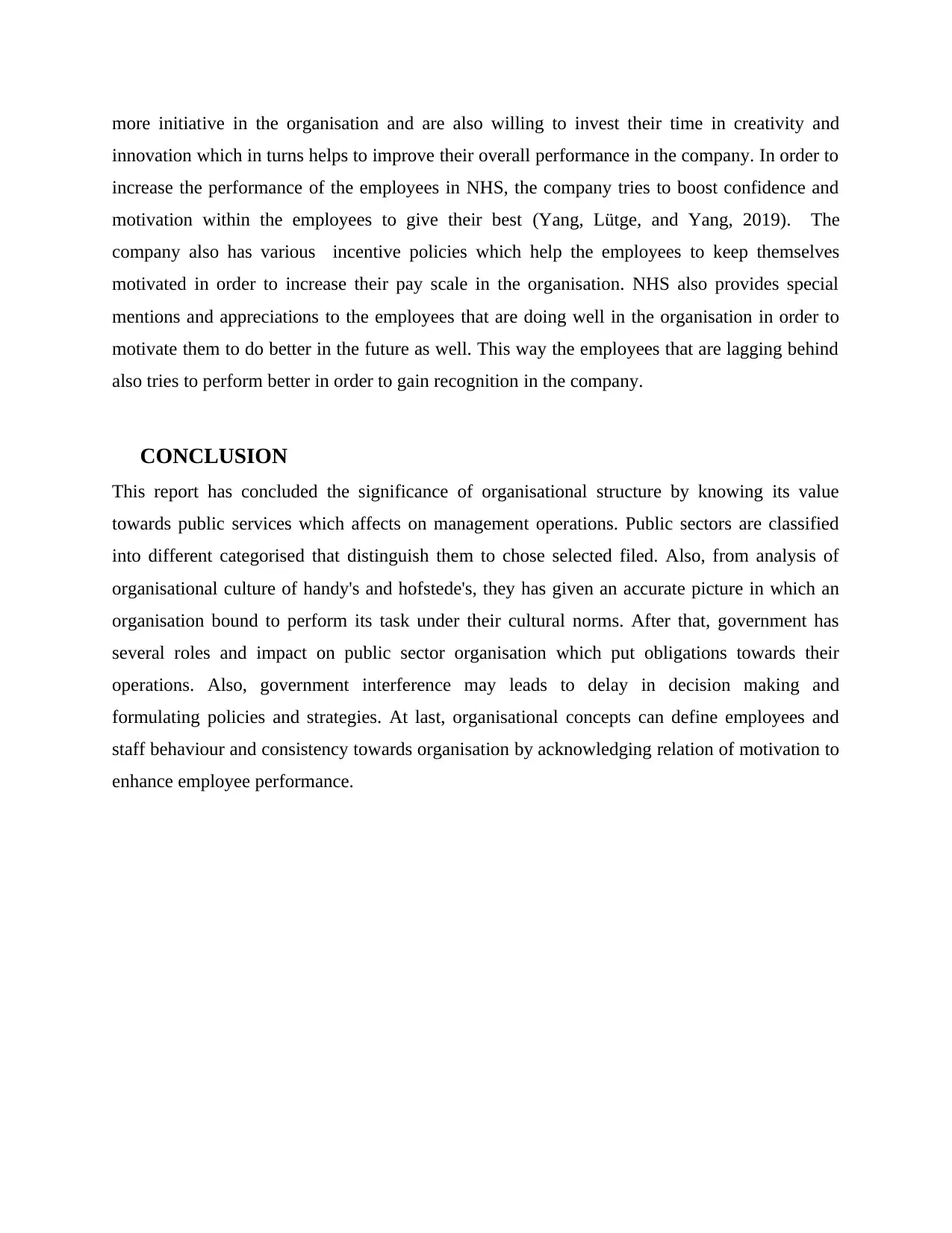
more initiative in the organisation and are also willing to invest their time in creativity and
innovation which in turns helps to improve their overall performance in the company. In order to
increase the performance of the employees in NHS, the company tries to boost confidence and
motivation within the employees to give their best (Yang, Lütge, and Yang, 2019). The
company also has various incentive policies which help the employees to keep themselves
motivated in order to increase their pay scale in the organisation. NHS also provides special
mentions and appreciations to the employees that are doing well in the organisation in order to
motivate them to do better in the future as well. This way the employees that are lagging behind
also tries to perform better in order to gain recognition in the company.
CONCLUSION
This report has concluded the significance of organisational structure by knowing its value
towards public services which affects on management operations. Public sectors are classified
into different categorised that distinguish them to chose selected filed. Also, from analysis of
organisational culture of handy's and hofstede's, they has given an accurate picture in which an
organisation bound to perform its task under their cultural norms. After that, government has
several roles and impact on public sector organisation which put obligations towards their
operations. Also, government interference may leads to delay in decision making and
formulating policies and strategies. At last, organisational concepts can define employees and
staff behaviour and consistency towards organisation by acknowledging relation of motivation to
enhance employee performance.
innovation which in turns helps to improve their overall performance in the company. In order to
increase the performance of the employees in NHS, the company tries to boost confidence and
motivation within the employees to give their best (Yang, Lütge, and Yang, 2019). The
company also has various incentive policies which help the employees to keep themselves
motivated in order to increase their pay scale in the organisation. NHS also provides special
mentions and appreciations to the employees that are doing well in the organisation in order to
motivate them to do better in the future as well. This way the employees that are lagging behind
also tries to perform better in order to gain recognition in the company.
CONCLUSION
This report has concluded the significance of organisational structure by knowing its value
towards public services which affects on management operations. Public sectors are classified
into different categorised that distinguish them to chose selected filed. Also, from analysis of
organisational culture of handy's and hofstede's, they has given an accurate picture in which an
organisation bound to perform its task under their cultural norms. After that, government has
several roles and impact on public sector organisation which put obligations towards their
operations. Also, government interference may leads to delay in decision making and
formulating policies and strategies. At last, organisational concepts can define employees and
staff behaviour and consistency towards organisation by acknowledging relation of motivation to
enhance employee performance.
⊘ This is a preview!⊘
Do you want full access?
Subscribe today to unlock all pages.

Trusted by 1+ million students worldwide
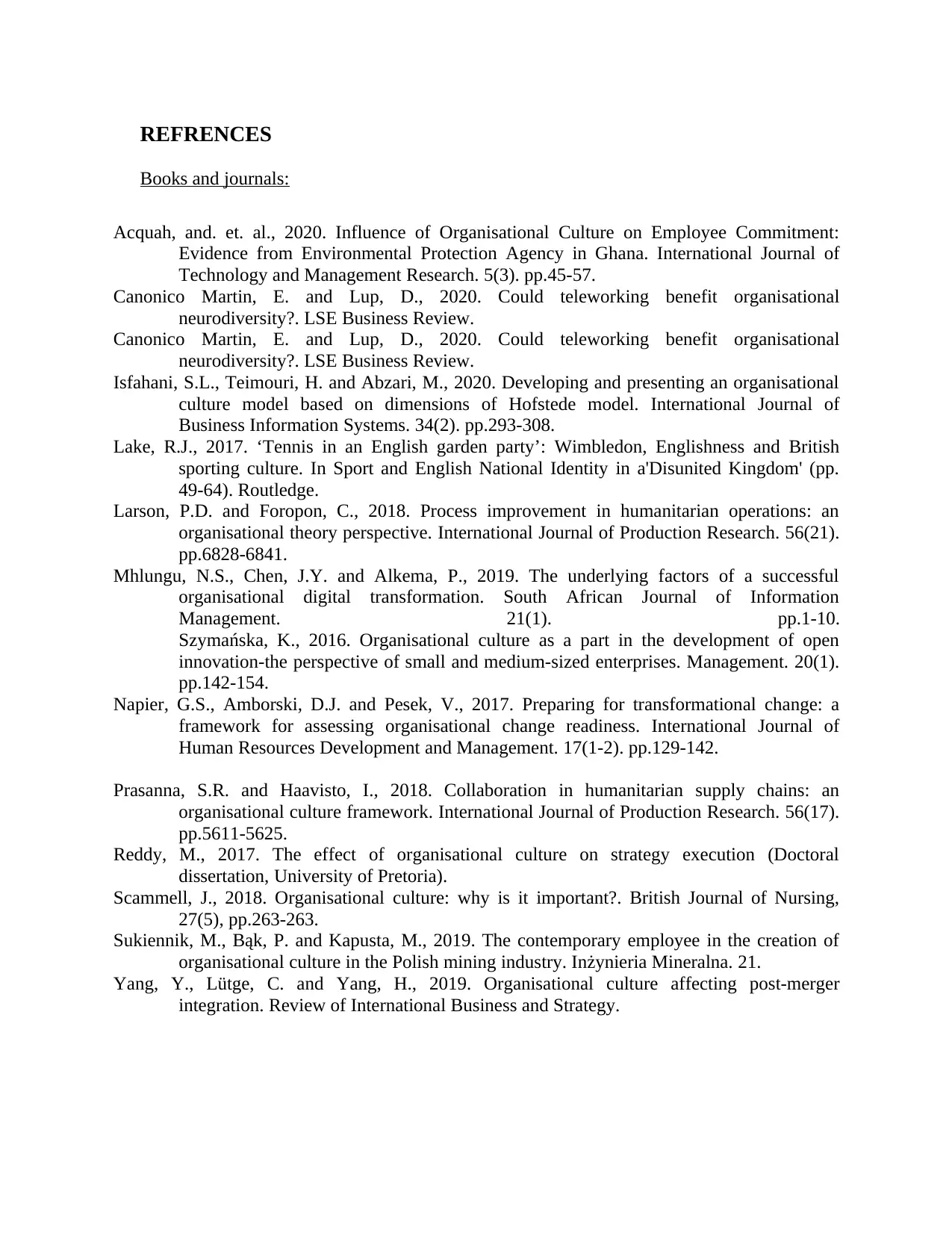
REFRENCES
Books and journals:
Acquah, and. et. al., 2020. Influence of Organisational Culture on Employee Commitment:
Evidence from Environmental Protection Agency in Ghana. International Journal of
Technology and Management Research. 5(3). pp.45-57.
Canonico Martin, E. and Lup, D., 2020. Could teleworking benefit organisational
neurodiversity?. LSE Business Review.
Canonico Martin, E. and Lup, D., 2020. Could teleworking benefit organisational
neurodiversity?. LSE Business Review.
Isfahani, S.L., Teimouri, H. and Abzari, M., 2020. Developing and presenting an organisational
culture model based on dimensions of Hofstede model. International Journal of
Business Information Systems. 34(2). pp.293-308.
Lake, R.J., 2017. ‘Tennis in an English garden party’: Wimbledon, Englishness and British
sporting culture. In Sport and English National Identity in a'Disunited Kingdom' (pp.
49-64). Routledge.
Larson, P.D. and Foropon, C., 2018. Process improvement in humanitarian operations: an
organisational theory perspective. International Journal of Production Research. 56(21).
pp.6828-6841.
Mhlungu, N.S., Chen, J.Y. and Alkema, P., 2019. The underlying factors of a successful
organisational digital transformation. South African Journal of Information
Management. 21(1). pp.1-10.
Szymańska, K., 2016. Organisational culture as a part in the development of open
innovation-the perspective of small and medium-sized enterprises. Management. 20(1).
pp.142-154.
Napier, G.S., Amborski, D.J. and Pesek, V., 2017. Preparing for transformational change: a
framework for assessing organisational change readiness. International Journal of
Human Resources Development and Management. 17(1-2). pp.129-142.
Prasanna, S.R. and Haavisto, I., 2018. Collaboration in humanitarian supply chains: an
organisational culture framework. International Journal of Production Research. 56(17).
pp.5611-5625.
Reddy, M., 2017. The effect of organisational culture on strategy execution (Doctoral
dissertation, University of Pretoria).
Scammell, J., 2018. Organisational culture: why is it important?. British Journal of Nursing,
27(5), pp.263-263.
Sukiennik, M., Bąk, P. and Kapusta, M., 2019. The contemporary employee in the creation of
organisational culture in the Polish mining industry. Inżynieria Mineralna. 21.
Yang, Y., Lütge, C. and Yang, H., 2019. Organisational culture affecting post-merger
integration. Review of International Business and Strategy.
Books and journals:
Acquah, and. et. al., 2020. Influence of Organisational Culture on Employee Commitment:
Evidence from Environmental Protection Agency in Ghana. International Journal of
Technology and Management Research. 5(3). pp.45-57.
Canonico Martin, E. and Lup, D., 2020. Could teleworking benefit organisational
neurodiversity?. LSE Business Review.
Canonico Martin, E. and Lup, D., 2020. Could teleworking benefit organisational
neurodiversity?. LSE Business Review.
Isfahani, S.L., Teimouri, H. and Abzari, M., 2020. Developing and presenting an organisational
culture model based on dimensions of Hofstede model. International Journal of
Business Information Systems. 34(2). pp.293-308.
Lake, R.J., 2017. ‘Tennis in an English garden party’: Wimbledon, Englishness and British
sporting culture. In Sport and English National Identity in a'Disunited Kingdom' (pp.
49-64). Routledge.
Larson, P.D. and Foropon, C., 2018. Process improvement in humanitarian operations: an
organisational theory perspective. International Journal of Production Research. 56(21).
pp.6828-6841.
Mhlungu, N.S., Chen, J.Y. and Alkema, P., 2019. The underlying factors of a successful
organisational digital transformation. South African Journal of Information
Management. 21(1). pp.1-10.
Szymańska, K., 2016. Organisational culture as a part in the development of open
innovation-the perspective of small and medium-sized enterprises. Management. 20(1).
pp.142-154.
Napier, G.S., Amborski, D.J. and Pesek, V., 2017. Preparing for transformational change: a
framework for assessing organisational change readiness. International Journal of
Human Resources Development and Management. 17(1-2). pp.129-142.
Prasanna, S.R. and Haavisto, I., 2018. Collaboration in humanitarian supply chains: an
organisational culture framework. International Journal of Production Research. 56(17).
pp.5611-5625.
Reddy, M., 2017. The effect of organisational culture on strategy execution (Doctoral
dissertation, University of Pretoria).
Scammell, J., 2018. Organisational culture: why is it important?. British Journal of Nursing,
27(5), pp.263-263.
Sukiennik, M., Bąk, P. and Kapusta, M., 2019. The contemporary employee in the creation of
organisational culture in the Polish mining industry. Inżynieria Mineralna. 21.
Yang, Y., Lütge, C. and Yang, H., 2019. Organisational culture affecting post-merger
integration. Review of International Business and Strategy.
Paraphrase This Document
Need a fresh take? Get an instant paraphrase of this document with our AI Paraphraser
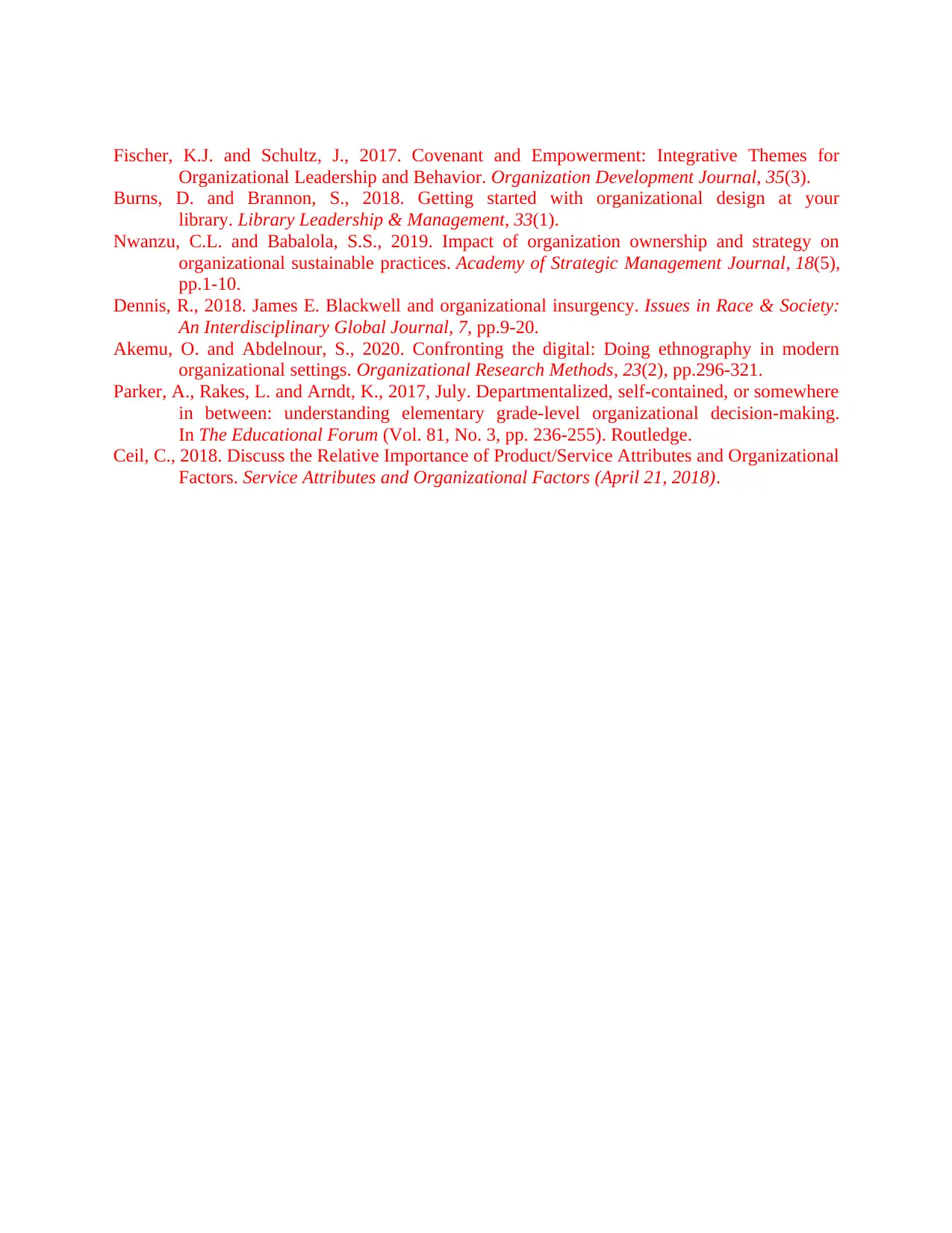
Fischer, K.J. and Schultz, J., 2017. Covenant and Empowerment: Integrative Themes for
Organizational Leadership and Behavior. Organization Development Journal, 35(3).
Burns, D. and Brannon, S., 2018. Getting started with organizational design at your
library. Library Leadership & Management, 33(1).
Nwanzu, C.L. and Babalola, S.S., 2019. Impact of organization ownership and strategy on
organizational sustainable practices. Academy of Strategic Management Journal, 18(5),
pp.1-10.
Dennis, R., 2018. James E. Blackwell and organizational insurgency. Issues in Race & Society:
An Interdisciplinary Global Journal, 7, pp.9-20.
Akemu, O. and Abdelnour, S., 2020. Confronting the digital: Doing ethnography in modern
organizational settings. Organizational Research Methods, 23(2), pp.296-321.
Parker, A., Rakes, L. and Arndt, K., 2017, July. Departmentalized, self-contained, or somewhere
in between: understanding elementary grade-level organizational decision-making.
In The Educational Forum (Vol. 81, No. 3, pp. 236-255). Routledge.
Ceil, C., 2018. Discuss the Relative Importance of Product/Service Attributes and Organizational
Factors. Service Attributes and Organizational Factors (April 21, 2018).
Organizational Leadership and Behavior. Organization Development Journal, 35(3).
Burns, D. and Brannon, S., 2018. Getting started with organizational design at your
library. Library Leadership & Management, 33(1).
Nwanzu, C.L. and Babalola, S.S., 2019. Impact of organization ownership and strategy on
organizational sustainable practices. Academy of Strategic Management Journal, 18(5),
pp.1-10.
Dennis, R., 2018. James E. Blackwell and organizational insurgency. Issues in Race & Society:
An Interdisciplinary Global Journal, 7, pp.9-20.
Akemu, O. and Abdelnour, S., 2020. Confronting the digital: Doing ethnography in modern
organizational settings. Organizational Research Methods, 23(2), pp.296-321.
Parker, A., Rakes, L. and Arndt, K., 2017, July. Departmentalized, self-contained, or somewhere
in between: understanding elementary grade-level organizational decision-making.
In The Educational Forum (Vol. 81, No. 3, pp. 236-255). Routledge.
Ceil, C., 2018. Discuss the Relative Importance of Product/Service Attributes and Organizational
Factors. Service Attributes and Organizational Factors (April 21, 2018).
1 out of 14
Related Documents
Your All-in-One AI-Powered Toolkit for Academic Success.
+13062052269
info@desklib.com
Available 24*7 on WhatsApp / Email
![[object Object]](/_next/static/media/star-bottom.7253800d.svg)
Unlock your academic potential
© 2024 | Zucol Services PVT LTD | All rights reserved.





